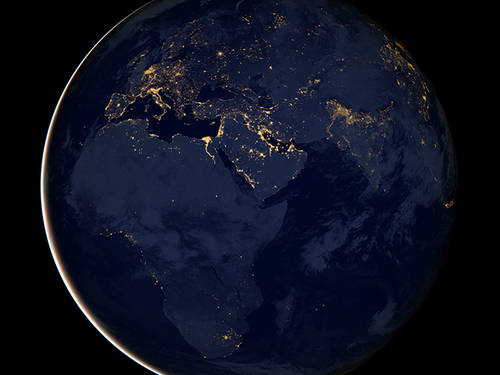Many people don't know that there’s more to scientist Isaac Newton than a certain apple falling from a tree. Holding a prism of glass in the path of sunlight, he showed that white light is actually made up of seven different colors – red, orange, yellow, green, blue, indigo, and violet. Color comes from light – in fact, color is light.
Just as Newton revealed the spectrum of colors that makes up white light, we must reveal to the world the importance of light in building a more sustainable and peaceful future. For this reason, 2015 has been designated by the United Nations as the International Year of Light and Light-based Technologies (IYL). Taken forward under UNESCO’s leadership, IYL is a unique opportunity to raise global awareness of how light-based technologies can provide solutions to global challenges in energy, education, agriculture and health. These technologies have the potential to transform the 21st century as electronics did in the 20th century.
 |
Earth in Night. (Photograph courtesy of NASA)
|
Throughout the Year, UNESCO will bring together key stakeholders including scientific societies and unions, educational institutions, technology platforms, non-profit organizations and private sector partners. Together, they will advocate for light technologies to improve the quality of life in developed and developing countries – be it through education for sustainable development (study after sunset is often not possible in developing countries), the reduction of light pollution and energy waste, women’s empowerment in science, or advocacy among youth.
IYL 2015 will kick off with opening ceremonies to be held 19-20 January 2015 at UNESCO’s Paris headquarters. The ceremony will see the launch of 1001 Inventions and the World of Ibn Al-Haytham, a global campaign where UNESCO will partner with the science and cultural heritage organization 1001 Inventions to announce a series of interactive exhibits, workshops and live shows illustrating the world of this remarkable scientist. Ibn Al-Haytham – often referred to as the ‘father of modern optics’ - was a pioneering polymath from Basra (in modern-day Iraq) who lived in the 10th century. He made significant advancements in optics, mathematics and astronomy, and helped lay the foundations of modern scientific method.
“I am pleased to partner with 1001 Inventions to launch the World of Ibn Al-Haytham Global Campaign, to promote light-science for the benefit of all,” said UNESCO Director-General Irina Bokova. “A ground-breaking scientist and a humanist from a thousand years ago, the life and work of Ibn Al-Haytham have never been as relevant as they are today.”
IYL will commemorate the achievements of scientific figureheads, who paved the way ahead for humanity’s understanding of light:
-
1015 – Ibn Al-Haytham’s Book of Optics;
-
1815 – Augustin-Jean Fresnel and the wave nature of light;
-
1865 – James Clerk Maxwell and electromagnetic waves;
-
1915 – Einstein’s theory of general relativity, exploring light through space and time;
-
1965 – Arno Penzias and Robert Wilson’s discovery of cosmic microwave background, and Charles Kao’s pioneering development of fiber optics, which enabled transformative technologies such as broadband today.
Learn more about the International Year of Light: www.iyl2015.org












